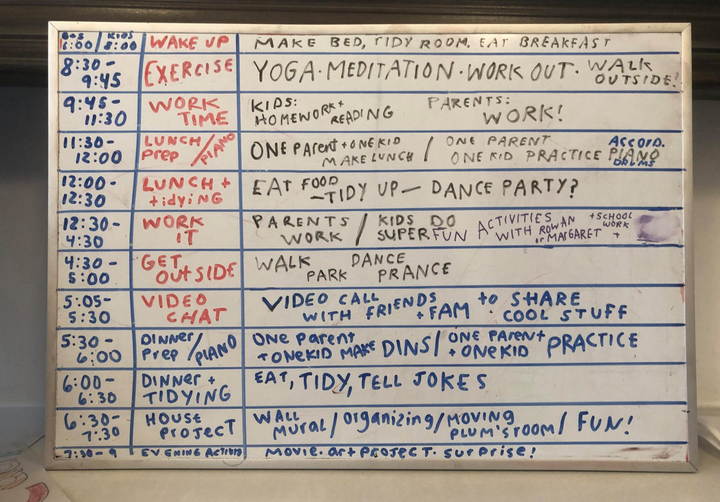In March, parents did all they could to adapt to having their children at home while schools closed. During this time, we shared many parents’ home-schooling schedules.
Now schools are being closed again in England, these might come in handy (for a second time).
Another schedule that circulated around online, nicknamed the “Covid-19 Daily Schedule,” was created by photographer Jessica McHale.
“Made this schedule to keep myself and my family sane through the unprecedented weeks ahead,” she wrote on Facebook. “Funny how everything works - it’s gotten picked up by behaviour groups, doctors, teachers, and has been shared more than 10k times that I know of. I feel like I just got an official mom trophy 😂”
Another parent shared their options for kids aged three to seven:
Writer and artist Sarah Lazarovic made this creatively oriented schedule for herself, her husband and their two kids, ages six and nine.

If you’re trying to figure out how to create a schedule for your kid, here are some tips.
Set a routine
Setting up expectations in the same way teachers do can be beneficial to kids and can help establish structure, Melanie Auerbach, director of student support at Washington D.C.’s Sheridan School, told The Washington Post. So having rules, like telling them they need to get dressed every day (no pyjamas!) and that they need to respect your authority in a school setting can help make it easier for everyone.
Use the info you already know about your kids
As a parent, you have an advantage on teachers, because of how much you already know about your kids. Think about how and when they learn best. Are they most alert in the morning, or do they work best in the afternoon? Is there anything specific that really motivates them to work hard? That’s all useful info to put into your schedule.
And while parents are clearly in charge of the schedule, it’s also a good idea to give kids some input, too. Spending a little more time on the subjects they’re most interested in can keep them engaged, and offer a ton of educational and social benefits.
Build in breaks and lunch
Kids need breaks. Make sure to factor in down time, alone time, and outdoor play (if possible) so that kids can recharge, chill out, and have fun. It’s also a good idea to build in a lunch break where they’re not working.
Be realistic
This is an unprecedented situation, and most parents don’t have experience doing this. So give yourself a break if you don’t stick precisely to your schedule.
Make it fun
There are actually some benefits to spending all this time together. Auerbach suggests finding ways to get creative with learning, like getting kids to put on plays, teach their parents some of their favourite subjects, or put their maths skills to use while cooking. Lots of things that aren’t explicitly academic can be learning opportunities, like taking a walk and looking at the trees and flowers.
Alexandra Stockwell, who homeschools her four kids, recommends taking some quarantine time to do family activities you might otherwise not have time for, like making home videos or writing letters of support to seniors living in isolation.
This article originally appeared on HuffPost Canada.
